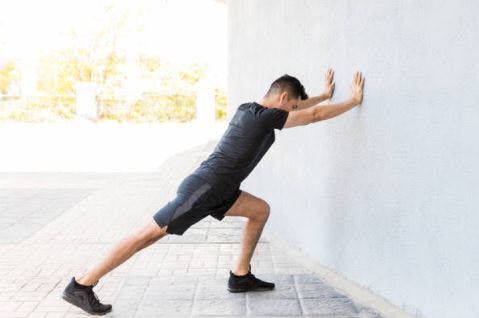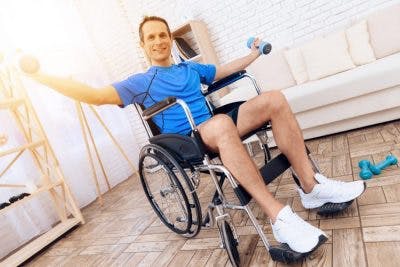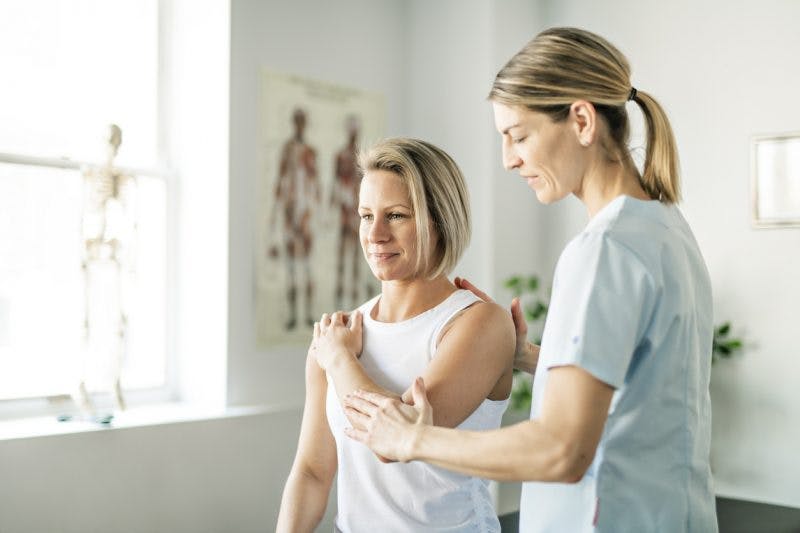The most effective exercises for adults with cerebral palsy will help them become as functional as possible and prevent secondary complications from worsening.
This article will share 15 effective exercises for individuals with cerebral palsy and their benefits.
Why Exercises for Adults with Cerebral Palsy Are Important
Exercising can increase range of motion, reduce the risk of depression, help you maintain a healthy weight, promote circulation, and keep your musculoskeletal system strong.
Because effects of cerebral palsy like spasticity (high muscle tone) can worsen over time, it’s essential to exercise to minimize their progression.
Everyone experiences cerebral palsy differently; therefore, a personalized approach to therapy is ideal. A physical therapist will access your functional abilities and create a custom rehabilitation plan.
Focus on the exercises you can do for challenge rather than frustration.
Want 19 pages of CP recovery tips in PDF form? Click here to download our free illustrated ebook now (link opens a pop up for uninterrupted reading)
Exercises to Boost Flexibility and Increase Range of Motion
Stretching is one of the most important exercises for individuals with cerebral palsy. A muscle must stretch before it can strengthen.
Stretching expands range of motion, reduces stiffness, lengthens tight muscles, and relieves pain.
1. Joint Rotations
To expand or maintain a healthy range of motion, perform rotations on all your major joints and the neck.
This includes the:
- Hips
- Knees
- Ankle
- Shoulders
- Elbows
- Wrists
Rotate them in one direction a few times, and then switch to the opposite direction.
This will combat stiffness and promote circulation.
2. Calf Stretch

Many individuals with cerebral palsy experience spasticity (involuntary muscle contractions) in their calves.
This can pull the heels up and result in abnormal gait patterns like toe-walking.
To lengthen tight calves, stand facing a wall and take a big step back with one leg. Adjust your legs so that the front leg is bent, and the heel of the back leg is raised.
Lean your arms against the wall for stability and gently lower the heel. Hold for 20-30 seconds and then switch legs.
3. Quadricep Stretch
Your quads are the muscles at the front of the thighs.
When they get tight, your knees may start to turn inwards and contribute to abnormal gait patterns.
To stretch your quads, sit on the floor with one leg bent back and the other out in front of you.
Gently lean back until you feel the strain, but not pain. Hold for 20-30 seconds and then switch legs.
4. Hamstring Stretch
Your hamstrings are muscles at the back of the thighs.
These muscles oppose the quads, so they also need to be lengthened to allow for regular hip and knee movements.
To stretch the hamstrings, sit on the floor with both legs straightened in front of you and lean your body forward in a pain free range. Hold for 30 seconds and repeat.
5. Shoulder Stretch
Raise one arm and bend it behind your head.
Use the hand of your other arm to gently press the elbow back until you feel the strain.
Hold for 20-30 seconds and then switch arms.
6. Arm Over Chest

Swing one arm across your chest and use the other arm to hold it in place.
Gently press the arm towards your body, so it wraps across the chest more tightly.
Hold for 20-30 seconds and then switch sides.
7. Trunk Tilts
Lay on your back and gently rotate your upper body to one side. The legs should not move.
Hold for 20 seconds and then rotate your upper body to the opposite side. This exercise will stretch the sides of your trunk.
8. Trunk Twists
Trunk twists can be performed sitting or standing. Place your feet on the floor and keep the lower body stable.
Gently twist your upper body to one side, hold for 20 seconds, and then twist to the other side.
What if You Have Quadriplegia?
Quadriplegia describes motor impairments that affect your entire body. It occurs more-so in the arms and legs, but it can also affect the muscles in the trunk and face.
Generally, quadriplegia is associated with more significant amounts of brain damage, which explains why more areas of the body are affected.
Individuals with quadriplegia may experience difficulties exercising due to their widespread motor impairments.
With the help of a physical therapist, nurse, or caregiver, people with quadriplegia can still practice range of motion exercises passively.
Passive range of motion exercises are when someone else moves your body for you. This allows you to reap the benefits of range of motion exercises like improved circulation without needing to exert any energy.
Exercises to Boost Cardiovascular Health
Cardio exercises can be adapted if you have motor impairments. Increasing your heart rate through cardio exercise pumping a few times a week is essential for maintaining healthy blood pressure.
9. Wheelchair Aerobics
If cerebral palsy primarily affects your legs or one side of your body, wheelchair aerobics can be an effective cardio workout.
It emphasizes upper body movement from a seated position.
10. Dancing
Dancing is an exercise that anyone can do anywhere and anytime.
For cardio, turn up some lively music. It’s proven that music influences physical changes in heart rate, blood pressure, muscle tension, and breathing.
Exercises to Strengthen the Muscles
Strengthening exercises preserve bone health, which decreases the risk of osteoporosis and fractures.
11. Wheelchair Pushes
For individuals who are affected by CP in the lower body, pushing your wheelchair is a great arm and chest strengthening exercise as well as a cardio workout
Push your wheelchair instead of having others push it for you as much as possible. This is an easy way to incorporate strength training into your daily routine.
12. Wheelchair Push-Ups
First, check that your wheelchair brakes are on. Then, sit on the edge of your seat with your feet flat on the floor.
Place your hands on the armrests and press down to lift your body up. Your feet should remain on the floor and be used to support some of your weight.
13. Resistance Band Training
Resistance bands are available in many different levels of resistance and can be used for a wide variety of muscle strengthening exercises.
14. Moving with Weighted Cuffs
An easy way to build strength is to wear some weighted cuffs around your wrists or ankles and go throughout the day.
An extra few pounds may seem like nothing, but they definitely add up over time.
15. Aquatic Exercises
Have you ever noticed how much more difficult it is to move quickly in water than it is on land?
This is because liquids have more viscosity (resistance) than gases.
The extra resistance will help strengthen the muscles.
Understanding Exercises for Adults with Cerebral Palsy

The most beneficial exercises for adults with cerebral palsy are going to be different for each person.
Every case of cerebral palsy is unique, and we all have our own preferences, so an individualized approach is ideal.
Any movement is better than no movement at all, so explore exercises you enjoy and make them part of your daily routine for long term recovery.











